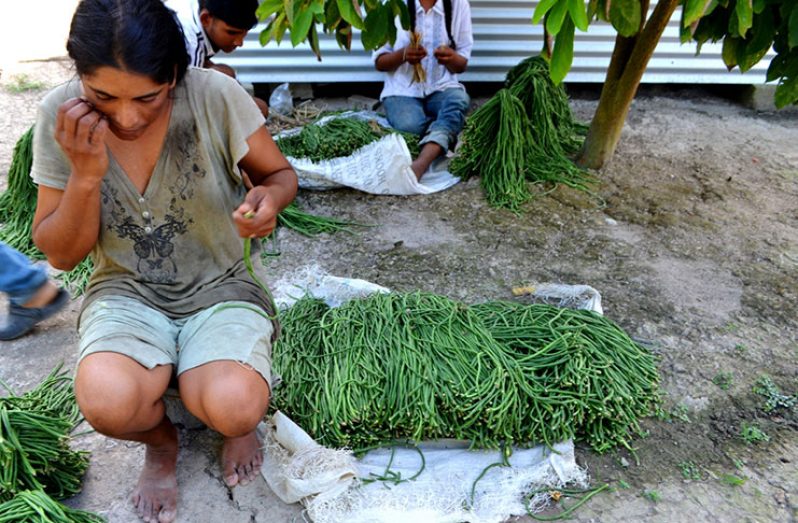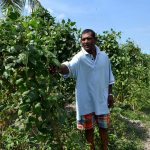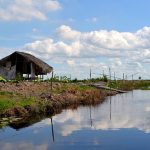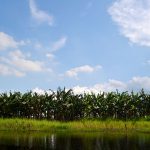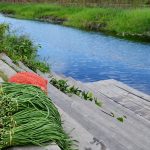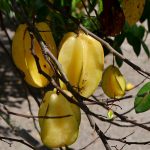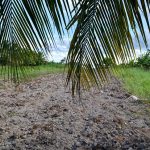–How Mahaica Creek farmers are coping with the vagaries of climate change
MAHAICA farmer, Rajesh Bissoondyal pointed to two long plots of land under bora cultivation, each measuring two acres in length.Nearby, his family of four was busy parcelling bora they had picked all morning; 15 strands of the vegetable were being loving placed into parcels and secured with a rubber band. They were being prepared for those vendors who would travel into the area during the afternoons and purchase “greens” from the farmers.
Rajesh said he had not slept a wink the night before; for him, this was an almost everyday occurrence, since farming is all he knows. And now that his daughter is preparing to enter medical school, he will be tilling the land for a long time to come.
But according to the dedicated farmer, his family’s well-being is a priority for him, so while climatic conditions impact the farming area annually, he will continue to plant his crops.
CHANGING WEATHER
Several years ago, the area was pounded by flood waters, and farmers suffered extensive losses as their crops folded under the rising water levels.
These days, however, Mahaica Creek farmers are experiencing long spells of dry weather, a phenomenon which illustrates the adverse effects changing weather patterns can have globally, which calls for proactive planning.
Last Sunday when the Guyana Chronicle paid the area a visit, the situation on the ground was almost similar to what obtained back in January, when the cash-crop-rich farming communities were starved of fresh water.
The only difference this time around, however, was that while the sun was scorching hot, water was readily available, thanks to the intermittent rains and the high water level of the Mahaica Creek.
The road to the farming areas stretches along the banks of the creek; but according to our boatman, Ravi, some farmers still prefer to move their produce by boat whenever the ‘greens van’ arrives.
Taking their cue, the Guyana Chronicle used a boat to get to where we were going, using Ravi as our guide.
On our arrival at GrassHook, where Rajesh lives, he was preparing to harvest a half-acre plot of the long bed of bora which lay before him. For him, weather conditions have become annoyingly unpredictable over the past decade.
“One time it raining; and then time like now, is plenty sun,” he said. The rains have not been steady at the Mahaica Creek over the past three months, but according to the farmers, the conditions these days have not reached the severity level of typical El Niño dry weather conditions which obtained between August 2015 and June/July this year.
Deochand Ramcharitar, who resides at Big Biaboo, also on the Mahaica Creek, plants cash crops in addition to his long lines of plantain stalks. He plants all year long he said, and according to him, while the weather conditions are dry at the moment, he has learnt to adapt.
“Since the Hope Canal, we don’t get dem kinda water we used to get; that one is the main thing them do,” he said, in obvious reference to those in authority.
MAHAICA CREEK
In the past, one of the major problems faced by farmers along the Mahaica Creek arose as a result of the flood waters which were thrown into the creek from the East Demerara Water Conservancy (EDWC) whenever the levels at the water holding area rose to critical levels.
“We almost used to know we faith when that used to happen,” Ramcharitar said, meaning that the farmers immediately knew that their crops would face destruction.
But since the construction of the Northern Relief Channel, and subsequently the Hope Canal, flooding seems to be a thing of the past for farmers at Mahaica Creek. At least for now.
“Well, the weather dry now,” Ramcharitar said. “De crop nah ah grow as they supposed to grow, but we have water.” Regarding the changing weather patterns, he said he’s grown accustomed to it by now, and knows just how to cope with it.
“For El Niño, we gotta try manage over it; that ah God wuk,” he said with a smile.
He sources water via a canal which runs at the back of the farmlands, he said.
Roopnarine Gangaram, the Handsome Tree farmer who complained about the lack of water during this publication’s visit in January, was in a much better frame of mind when we spoke last weekend.
Following the dry El Niño-like weather conditions, there was a period of rainfall, which he noted assisted his crops greatly. But in recent weeks, the dry conditions have taken a severe toll on some aspects of the farmlands; even though water is available.
“De plant dem, yuh gat to really water them,” he said, adding that he currently has several beds of peppers, corolla and bora under cultivation. The plants are almost a month old. He had dug a reservoir near his farm, which collects rain water; he utilises the water from the reservoir for his crops.
A MARKED DROP
The El Nino dry weather conditions earlier in 2016 resulted in a marked drop in the water level in various parts of the country.
Rainfall figures indicated at the time that the weather pattern changed significantly around July-August last year.
The EDWC, which stores water to irrigate farmlands on the East Coast and water for Guyana Water Inc’s Shelter Belt location in Georgetown, is often the benchmark for critical consumption and use of water.
In recent weeks, high temperatures have been experienced across the coastland, with dry weather conditions occurring almost daily.
For the month of September, the temperature stood at 35 Degrees Celsius, almost 70 per cent of that of the previous month. However, several forecast models have indicated that the dry spell may change in the weeks ahead.




.png)


